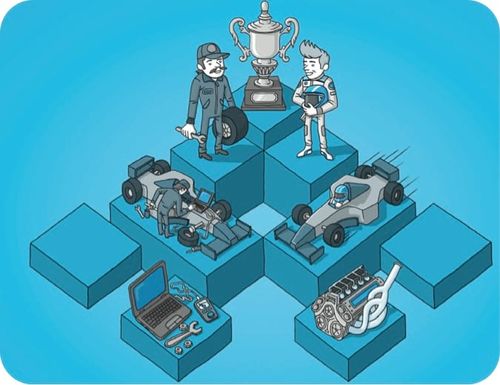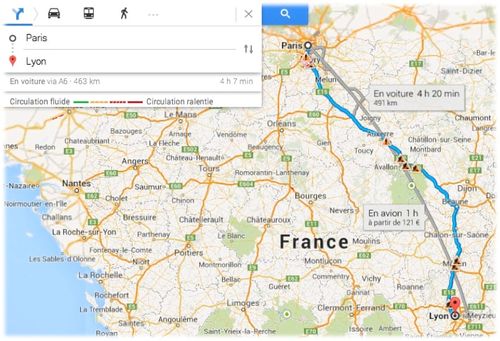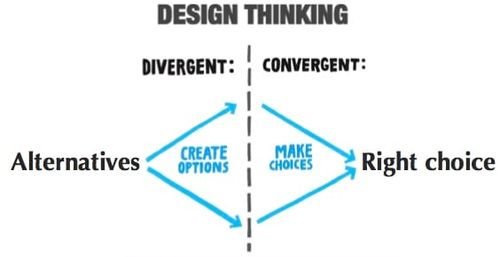Impact mapping: business success in software development
We had a chance to meet the author of Impact Mapping Gojko Adzic at OCTO Technology. After the interview and Product Owner Survival Camp workshop attendance in London, where Gojko explained us the advantages of this new method, we would like to share with you some ideas about it.
What is Impact Mapping?
Impact mapping is a visual strategic planning technique that helps teams to align their activities with overall business objectives and make a better decision.

Impact Mapping prevents organisations from getting lost while building products and delivering projects by clearly communicating assumptions.
Why do I need it?
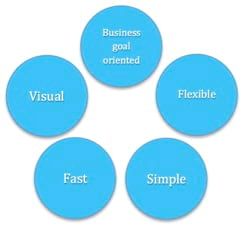
Impact mapping helps you to:
- produce more value with less software (business goal oriented);
- improve the collaboration and interaction like post-it or Kanban or Storymap (visual);
- get started easily (fast);
- facilitate strategic planning and thinking for a better decision making (big picture thinking);
- test the hypothesis and fail fast finding the better way, then validate a new hypothesis and go on (multiple criteria);
- align technical experts and managers (simple);
- adapt quickly to changing market needs (flexible).

How does it work?
As I said it’s simple. There are only two steps to make your impact map. First is the meeting with stakeholders. Second, make it visual.
Preparation
- On the first step realize what is the business goal asking the stakeholder why we are going to do this job.
- Then define the actors suggesting who could help us to achieve this goal, who we want to help, who are our customers.
- The next question would be how could they help us to reach the goal.
- And the last thing we will treat together is what could we do to support the required impact.

Mapping
Then the next time you will come to see your stakeholder, to make sure that you understood the right thing and all together you are going to the right goal, draw the map.
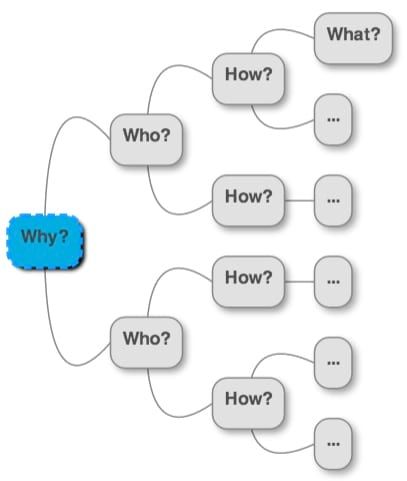
Examples
Racing competition
Imagine that you want to win a race with your team. There are at least two people who can make it possible: pilot and mechanic. They have their own ways to make better their job: for pilot drive faster, for mechanic make a faster pit stop. What would help them to achieve this? Better engine for pilot’s car or state-of-the-art tools for mechanic.
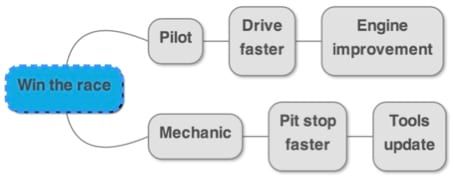
This map shows how to extract multiple possible solutions for a goal achievement.
Online gaming
Here is another example. Why do we meet today? To find the way to enhance the number of players up to 1 million. Who can help us? Players can invite new people, internal team and advertisers could attract new players as well. How could they do this? Inviting friends and sharing the results, organizing new events and promoting the game. Then just chose what you want to start from. When you’ll find the very first step in your new product or feature development, don’t forget about the easiest way to test your hypothesis - the minimum viable product for fast and quantitative market testing.
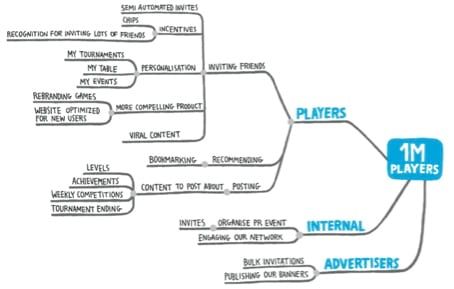
Plan your trip
We are talking about impacts. Here is one example of our daily life. To get from point A to point B we can use different type of transport and different roads that will influence travel cost and time. Isn’t it easier to make a decision when it’s visual and we can compare different ways?
Some secrets
Define SMART goals
Specific – target a specific area for improvement.
Measurable – quantify or at least suggest an indicator of progress.
Assignable – specify who will do it.
Realistic – what results can realistically be achieved, given available resources.
Time-related – specify when the result can be achieved.
Create options to make a better choice
Measure everything
More profit… How much more is more?

Assign and validate measureable values of your success.
Make each step meaningful
Rethink your user stories, make them lead you to a real business goal.
Interview with Gojko Adzic
How to define a good goal?
Make it measurable. Make sure that it changes somebody's behaviour. Use 5 Whys to reach the real client needs and success criteria.
Use some key questions to facilitate goal finding. You are asked to make a function/project, climb up on the demand stairs. Usually people tell you the solution, but not their needs.
Example: I want to go to a bar and take a beer. But the goal behind is socialization or relaxation.
Ask: What you really want to archive? > Why is it important? > Use iterative "Why" (5 whys technique or ask "Why" in different way) until client will tell you "This is a ridiculous question. It lets us to earn more money". You will find the right goal doing this.
You could find that the thing that was asked is not at all the thing the client really need. You can lose the realization of project, but win a lot of money for a client and be asked for another analysis later because of good goal definition. Help client to prove that "There is a better way" ;)
For what type of client I can use Impact Mapping?
There are no limits. Impact Mapping is the way to visualize the enterprise strategy.
Typically Gojko uses it for big financial organisations.
Who participate in a workshop?
Senior technical and business people.
Business people help to define a good goal. Technical people propose a better implementation.
Who is Impact Mapping for?
For senior technical and business people. It helps them to visualize the strategy and align the vision to reach the goal faster.
How to apply Impact Mapping in Product Owner's life?
In prioritization management and User Story definition.
Usually this method is used for senior business and technical people. But Product Owner could use it to visualize its product vision with the client. And on the User Story level you could change the standard template: "As... I want... for ..." to goal oriented one like "... can help us to achieve... by ... faster/better"
How to apply Impact Mapping on the Low Level approach for a single project of IT department?
You probably don't need Impact Mapping on the Low level when you don't have a senior business people and clear strategy.
However, think how to minimize output (number of useless functionalities/User Stories) and maximize outcome (business value).
What is a timeline for Impact Mapping?
Usually it's from 6 months to 5 years.
But it depends whether you can define a clear goal for a shorter period of time than it will work too.
Can I change the goal in process?
Sure.
The most important is to reach the goal as soon as possible, if it's done, then chose a next one.
http://www.slideshare.net/slideshow/embed_code/33841592
Links
Slides Impact Mapping:
http://fr.slideshare.net/SergeyLA/impact-mapping-short-octo
Impact Mapping by Gojko Adzic:
Video presentation by Gojko Adzic:
http://www.youtube.com/watch?v=PGW631c4cO0
Slides Web Giants (in Fench):
http://www.slideshare.net/OCTOTechnology/minicourse-web-giants/

